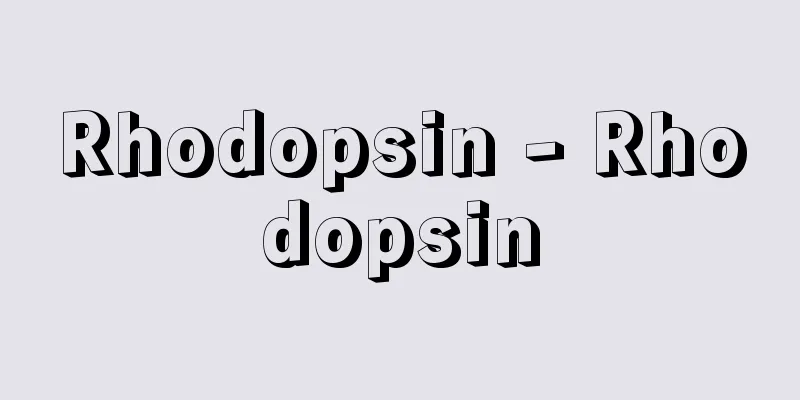Rhodopsin - Rhodopsin

|
It is a red pigment protein (visual pigment or visual pigment) contained in the disc membrane of the rods or rod cell outer segments of the photoreceptor cells in the retina of vertebrates, and is also called visual purple. Its chromophore is 11-cis-retinal, an aldehyde derivative of vitamin A, which is bonded to the protein opsin (the protein part of rhodopsin) with 348 amino acids, a molecular weight of 39,048, and a diameter of about 10 nanometers (1 nanometer is one billionth of a meter) by forming a Schiff base with the ε (epsilon)-amino group of lysine. In the dark, it is purple-red, and when exposed to light, it turns from red to orange, then yellow retinal (retinene = visual yellow), and then colorless retinol (vitamin A 1 = visual white). The optical cycle is called the visual cycle, and it goes through five or six intermediate forms with different absorption bands: bathorhodopsin (possibly via hypsorhodopsin), lumirhodopsin, metarhodopsin-I, -II, and -III to become all-trans-retinal, which then fades and returns to its original color when light is removed. Opsins include rod opsin (scotopsin, molecular weight approximately 38,000), which distinguishes light from dark (mesopic vision), and cone opsin (photopsin), which distinguishes color (diurnal vision). Rhodopsin was first extracted from frog retina in 1877 by German physiologist Wilhelm Kühne (1837-1900). Opsin is a water-insoluble membrane protein, so a detergent was used. Bovine opsin has two glycan chains (a series of sugars such as glucose) consisting of seven to eight monosaccharides, and is modified with two molecules of palmitic acid. The sequence of 348 amino acids was determined in 1982. Half of the amino acid composition is made up of hydrophobic amino acids. The polypeptide chain of rhodopsin has its amino terminus exposed inside the disc body and its carboxy terminus exposed to the rod cytoplasm, and the middle part crosses the disc body membrane seven times. Most of the intramembrane part forms an α (alpha)-helix (one of the stable helical structures that a polypeptide chain can take). When rhodopsin is exposed to light, it has a very short life span and separates into all-trans-retinal and opsin via several intermediates with different colors. During this process, transducin, a GTP (guanosine triphosphate)-binding protein (G-protein) on the membrane surface, binds to rhodopsin and becomes activated, which in turn activates phosphodiesterase (an enzyme that produces monophosphate esters), converting cyclic GMP to 5'-GMP (guanylic acid). This causes the influx of sodium ions (Na + ) into the rod cells to stop, calcium ions (Ca 2+ ) to flow out, and the surface potential of the disc membrane to change, converting light energy and information into nerve signals and transmitting them to the brain. Vitamin A deficiency causes idiopathic night blindness (nyctalopia) because of insufficient production of rhodopsin. Some extremely halophilic bacteria have bacteriorhodopsin, which is very similar to rhodopsin, and perform photosynthesis. Additionally, arrestin (S antigen) in retinal photoreceptor cells has a molecular weight of approximately 48,000 and 438 amino acids, and binds to phosphorylated rhodopsin to inhibit the interaction between rhodopsin and transducin. The three-dimensional structure of bovine rhodopsin was determined at a resolution of 2.8 angstroms (Å) in 2000. In 2003, a portion of the retinal opsin of ayu fish from Lake Biwa was cloned (isolating a specific gene; cloning). Furthermore, in the same year, a group from the European Molecular Biology Research Institute determined the three-dimensional structure using two-dimensional crystals with a cryo-electron microscope. [Koji Nomura] "Vision" by Maeda Akio (1986, Kagaku Dojin)" ▽ "Illustrated Information Biological Science" by Takagi Masayuki (1988, Asakura Shoten)" ▽ "Neuro-information transmission molecules - aiming for understanding brain function at the molecular level" edited by Kasai Michio et al. (1988, Baifukan)" ▽ "New perspectives on protein three-dimensional structure" edited by Morikawa Kosuke (1991, Kodansha)" ▽ "The mechanism of vision" by Maeda Akio (1996, Shokabo)" [References] | | | | | | | | | | | | | | |Source: Shogakukan Encyclopedia Nipponica About Encyclopedia Nipponica Information | Legend |
|
脊椎(せきつい)動物の網膜retinaにある視細胞のうち桿体(かんたい)rodまたは桿状体細胞外節の円板体膜に含まれる赤い色素タンパク質(視物質または視色素)で、視紅visual purpleともよばれる。ビタミンAのアルデヒド誘導体である11-シス-レチナールを発色団とし、これとアミノ酸348個、分子量3万9048、直径約10ナノメートル(1ナノメートルは10億分の1メートル)のタンパク質オプシン(ロドプシンのタンパク質部分)とが、リジンのε(イプシロン)-アミノ基とシッフ塩基をつくって結合したものである。暗所では紫紅色、光に当てると赤色から橙色を経て黄色のレチナール(レチネン=視黄)となり、さらに、無色のレチノール(ビタミンA1=視白)となる。それぞれ異なる吸収帯を示す5~6種の中間体、バソロドプシン(ヒプソロドプシンを経由することもある)、ルミロドプシン、メタロドプシン-Ⅰ、-Ⅱ、-Ⅲを経て全トランス‐レチナールになって退色し、光を遮ると回復する(これを視覚サイクルという)。オプシンには明暗を区別する(薄明視)桿体オプシン(スコトプシン、分子量約3万8000)と、色を区別する(昼間視)錐体(すいたい)オプシン(フォトプシン)がある。 ロドプシンは1877年、ドイツの生理学者キューネWilhelm Kühne(1837―1900)がカエルの網膜から初めて抽出した。オプシンは、水不溶の膜タンパク質なので界面活性剤を用いた。ウシのオプシンは単糖7~8個からなる糖鎖(グルコースなどの糖がいくつかつながったもの)を二つもち、2分子のパルミチン酸で修飾されている。348個のアミノ酸配列は1982年に決定された。アミノ酸組成では疎水性アミノ酸が半分を占める。ロドプシンのポリペプチド鎖はアミノ末端を円板体内部に、カルボキシ末端を桿体細胞質側に露出し、中間部分は7回円板体膜を横切っている。膜内部分はほとんどα(アルファ)-ヘリックス(ポリペプチド鎖がとりうる安定な螺旋(らせん)構造の一つ)を形成している。ロドプシンは光を受けると、寿命が非常に短く、色の異なる数種の中間体を経て全‐トランス‐レチナールとオプシンに分離する。この過程で、膜表面にあるGTP(グアノシン三リン酸)結合タンパク質(G-タンパク質)の一つであるトランスデューシンtransducinがロドプシンに結合して活性化され、これがさらにフォスフォジエステラーゼ(リン酸モノエステルを生成する酵素)を活性化するため、サイクリック(環状)GMPが5'-GMP(グアニル酸)に変化する。これによりナトリウムイオン(Na+)の桿体細胞内への流入停止とカルシウムイオン(Ca2+)の流出、円板膜の表面電位の変化などが生じ、光のエネルギーと情報が神経信号へ変換して脳へ伝えられる。ビタミンAの不足で特発性夜盲症nyctalopiaになるのは、ロドプシンの生成が不十分になるからである。なお、ある種の高度好塩菌はロドプシンによく似たバクテリオロドプシンをもち、光合成を行う。 また、網膜視細胞にあるアレスチンarrestin(S抗原)は分子量約4万8000、アミノ酸438個で、リン酸化されたロドプシンに結合してロドプシンとトランスデューシンとの相互作用を阻害する。ウシ‐ロドプシンの立体構造は2000年に2.8オングストローム(Å)解像度で決定された。なお、2003年(平成15)、琵琶湖(びわこ)のアユの網膜オプシンの一部がクローニング(特定の遺伝子を単離すること。クローン化)された。さらに同年、ヨーロッパ分子生物学研究機構のグループが二次元結晶を用いて超低温電子顕微鏡によって立体構造を決定した。 [野村晃司] 『前田章夫著『視覚』(1986・化学同人)』▽『高木雅行著『図説 情報生物科学』(1988・朝倉書店)』▽『葛西道生他編『神経情報伝達分子――脳機能の分子レベルでの理解をめざして』(1988・培風館)』▽『森川耿右編『蛋白質立体構造の新しい視点』(1991・講談社)』▽『前田章夫著『視覚のメカニズム』(1996・裳華房)』 [参照項目] | | | | | | | | | | | | | | |出典 小学館 日本大百科全書(ニッポニカ)日本大百科全書(ニッポニカ)について 情報 | 凡例 |
>>: Rhodohypoxis - Rhodohypoxis
Recommend
Commerce - shogyo (English spelling) commerce
A general term for economic activities related to...
Kinkenchochikukai - thrift savings association
...The basis of this movement was to focus on the...
Continuing expenses
Some expenses in the national budget are related ...
Hired bus service - Kashikiri Bus (English name)
A bus that charters transportation by vehicle acco...
Austronesian peoples - Austronesian peoples
Austronesian is a general term for peoples who spe...
Aiyar - Aiyar
Of course, this Mamluk system was not without opp...
Rental kettle - Kashigama
This refers to the system and practice of lending ...
Griffith flaw (English spelling) Griffithflaw
...This refers to plate glass that has been therm...
Urahoro [town] - Urahoro
A town in Tokachi County, Hokkaido. Most of the to...
Rintaro Imai - Rintaro Imai
However, it is important to note that each of the...
Indigo dyeing
A dyeing method in which threads and cloth are dye...
Coastal forces and coastline development - Coastal forces and coastline development
…He became a professor at Columbia University in ...
Doctrine of illumination
An epistemological principle asserted especially i...
Yupanqui
Argentine composer and singer. He is also a folklo...
Kashii Shrine
Located in Kashii, Higashi-ku, Fukuoka City. It e...



![Geigy [company] - Geigy](/upload/images/67cfe67ce9169.webp)





